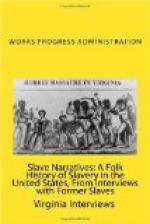“I have lived here ever since I came here. I was married when I was about thirty years old. I married a slave girl from Georgia. Back in Missouri, if a slave wanted to marry a woman on another plantation he had to ask the master, and if both masters agreed they were married. The man stayed at his owners, and the wife at her owners. He could go to see her on Saturday night and Sunday. Sometimes only every two weeks. If a man was a big strong man, neighboring plantation owners would ask him to come over and see his gals, hoping that he might want to marry one of them, but if a Negro was a small man he was not cared for as a husband, as they valued their slaves as only for what they could do, just like they would horses. When they were married and if they had children they belonged to the man who owned the woman. Osceola is where the saying originated, ‘I’m from Missouri, show me.’ After the war the smart guys came through and talked the people into voting bonds, but there was no railroad built and most counties paid their bonds, but the county in which Osceola stands refused to pay for their bonds because there was no railroad built, and they told the collectors to ’show me the railroad and we will pay,’ and that is where ‘show me’ originated.”
“My wife died when we had three children. She had had to work hard all her life and she said she didn’t want her children to have to work as hard as she had, and I promised her on her death bed, that I would educate our girls. So I worked and sent the girls to school. My two girls both graduated from Ottawa university, the oldest one being the first colored girl to ever graduate from that school. After graduation she went to teach school in Oklahoma, but only got twenty-five dollars a month, and I had to work and send her money to pay her expenses. The younger girl also graduated and went to teach school, but she did not teach school long, until she married a well-to-do farmer in Oklahoma. The older girl got her wages raised until she got one hundred and twenty-five dollars per month. I have worked at farm work and tree husbandry all my life. My oldest daughter bought me my first suit of clothes I ever had.”
“I have been living alone about twenty-five years. I don’t know hew old I was, but my oldest daughter had written my mother before she died, and got our family record, which my mother kept in her old Bible. Each year she writes me and tells me on my birthday how old I am.”
THE AMERICAN GUIDE TOPEKA, KANSAS
Ex slave story
Hutchinson, Kansas
interviewer: E. Jean Foote
Belle Williams was born in slavery about the year 1850 or 1851. Her mother’s name was Elizabeth Hulsie, being the slave of Sid Hulsie, her last name being the name of her master. The Hulsie plantation was located in Carroll County, Arkansas. Belle Williams, better known as “Auntie Belle” is most interesting. She lives in her own little home in the one hundred block on Harvey Street, Hutchinson, Kansas. She is too old and crippled to do hard work, so spends most of her time smoking her pipe and rocking in her old armchair on the little porch of her home. She is jolly, and most interesting.




